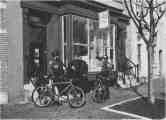KEEPING DOWNTOWN SAFE
By DOLORES P. PALMA, HyettPalma, Inc.
About the Author
Dolores P. Palma is the president of HyettPalma, Inc., the only national consulting firm specializing in the economic renaissance of business districts. Based in Alexandria, VA, the firm has served hundreds of business districts from throughout all 50 states. The firm's work has been featured in numerous publications, including The New York Times, American City 6- County Magazine, Public Management Magazine, and Nation's Cities Weekly.
Safety has become a prominent issue in many downtowns all across the country today. When dealing with this issue, downtown leaders frequently find that safety concerns are more often rooted in perception than reality. In terms of downtown safety, perception is reality
the issue must be addressed and resolved if our downtowns are to thrive economically.
A downtown that is unsafe or that is perceived to be unsafe will not be able to attract the customers, users, and investors needed for that economy to flourish. Therefore, the issue of safety must be addressed as part of an overall downtown enhancement effort.
Effective Safety Strategies
Several communities have devised innovative strategies for improving the perception and reality of downtown safety. Here's a list of the "best of the best" from across the nation.
Robbinsdale, MN Foot Patrol
To have a "friendly face on the street everyday"
and not simply during times of crisis the City of Robbinsdale has decided to hire an officer to walk the streets of downtown. This decision was made as part of an aggressive and proactive strategy which is being implemented to enhance Robbinsdale's downtown. A portion of the funds for downtown Robbinsdale's beat officer come from President Clinton's program to get 100,000 additional officers on patrol throughout the nation's cities.
Alexandria, VA Bike Patrol
In 1992, the City of Alexandria started a bicycle patrol at the suggestion of two of the force's female officers. The bike patrol was launched as a four-month pilot program, and during that period, the patrol tripled the number of contacts usually made with the public.

Bike patrol officers visit merchants in Old Town Alexandria.
As a result, the patrol has been continued and expanded with Alexandria's bike-trained officers now numbering over 20.
The patrol is unusual in that its officers do not respond to calls; instead all of the patrol's contacts with the public and with law offenders are "self-initiated." Officers find that their bikes act as ice-breakers, giving business owners, employees, pedestrians, and tourists a reason to start conversations with officers conversations which often lead to more serious discussions about safety concerns and needs. And, business owners in Old Town Alexandria will often step out of their stores to offer water and soft drinks to the bike patrol, which acts as a first step in opening the door to better communication and understanding between the City's merchants and police.
Alexandria's bike patrol is also unusual in that no local tax dollars are used to buy the patrol's uniforms or equipment. Instead, all bike patrol uniforms and equipment are purchased using seized assets from drug-related arrests.
Morris, IL Curfew and "Door Shakes"
Several years ago, the main street of downtown Morris became a popular hang-out for local teens, as well as for teens from neighboring communities. The situation became so critical that in excess of 200 teens
March 1996 I Illinois Municipal Review / Page 11
could be found congregating there on weekend nights during the school year and on most nights during the summer. Traffic would be bumper-to-bumper as kids honked, waved, and visited with friends.
According to police officials, the large numbers of kids encouraged their bringing alcohol, which led to fights, breaking of store windows, and other forms of vandalism. To keep the situation under control required the Morris Police Department to assign one squad car and 4-8 foot walkers specifically to downtown on weekend nights.
In August of 1993, the City of Morris began to enforce curfew legislation requiring teens under 16 to be home by 9 PM seven days a week and teens from 16 up to 18 years old to be in by 10 PM. Teen attendance at school activities, church activities, and work are not restricted by the curfew. The curfew was put into place on a Saturday night and not one person violated the curfew on that first night. Since then, there have been very few curfew violations, kids no longer congregate downtown, and the Morris Police Department has found it no longer necessary to assign patrols specifically to the downtown area. Police Department personnel routinely work with parents and local schools to find alternative activities for the community's teens.
To further enhance safety, police conduct a "door shake" every night between 10 PM and 7 AM. This entails two officers walking downtown and shaking every front and back door of every downtown business once a night at varying times.
St. Charles, IL Respectful Skateboarding and Rollerblading
The City of St. Charles, with a large elderly population living downtown, had placed a ban against skate-boarding and rollerblading on downtown sidewalks. Still, those activities continued with growing tension between seniors and youth. The situation came to a head when a merchant was hit by a skateboarder and sent to the hospital with a broken arm and bloody nose.
At the instigation of local aldermen, the City's Community Oriented Policing Program (COPP) was used to address and resolve the issue. At the suggestion of aldermen, the City arranged for seniors and youth to meet and discuss the situation. Aldermen, police personnel, and St. Charles Mayor Fred Norris attended the meeting and participated in the discussion which Mayor Norris termed "very enlightening."
Prior to the meeting, the St. Charles Police Department videotaped skateboarding and rollerblading to show the actions and reactions of both seniors and youth. The video was shown early in the meeting, which started off with heated dialogue seniors expressing their fears of injury and youth expressing their belief that their actions were not dangerous. However, participants quickly moved toward looking for a win-win solution. Seniors and youth agreed that both sides have rights and that there should be room for both if there is consideration and empathy for each other's positions.
Participants at the meeting agreed that the ban on skateboarding and rollerblading should be lifted

In St. Charles, local elected officials put COPP to work and resolved downtown's skateboard and rollerblade issues.
which the City did in August 1995. Today, rollerblading and skateboarding on downtown sidewalks must take place at a moderate speed and in a careful, caring manner that does not pose a threat to anyone. The new system works in the following manner. If an officer sees skateboarding or rollerblading occurring in a way that poses a threat, the offender is issued a warning ticket. If that person is a minor, his/her equipment is confiscated and must be picked up at the police station with the parents. If a second violation occurs, the youth goes into consultation with police officers. And, if a third violation occurs, a ticket is issued. To date, police have not had to issue any tickets under the new system.
Page 12 / Illinois Municipal Review / March 1996